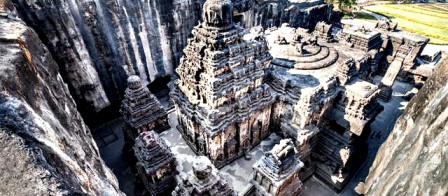Pallava Dynasty – History Study Notes & Stuff
In the Tamil country after the Sangam age, Kalabhras ruled for 250 years. There was Pallava kingdom in Tondaimandalam. Their had the capital at Kanchipuram.
The Origin of Pallava is disputed, while many consider them to natives. They Issued earlier inscriptions in Prakrit & Sanskrit and patronised Brahmanism.
Vishnugopa:
Simhavishnu:
Simhavishnu was real founder of Pallava dynasty. He was a great ruler who defeated the Kalabhras, the Cholas, to extend the territory up to the Kaveri.
Mahendravarman I (400–830 AD):
The conflict between the Pallavas and the Chilukyas began. Pulakeshin II occupied the northern part of his kingdom. He was a Jain follower, but converted to Saivism after coming under the influence of Saiva saint, Tirunavukkarasar/Appar.
He is considered the creator of cave temples as temples were built for Brahma, Vishnu and Shiva in his time. He also promoted art and music.
Narasimhavarman I (630-668 A.D.) :
Also known as Mamallan which means ‘great wrestler’. He defeated Pulakeshin II of the Western Chalukyas in the Battle of Manimangalam near Kanchi. He captured and destroyed the capital of Vatapi. He then assumed the title of 'Vatapikkonda'. He led a naval expedition in Sri Lanka.
During his reign, Hiuen Tsang visited Kanchipuram and described it as large and beautiful with one hundred Buddhist monasteries along with ten thousand Buddhist monks. The Ghatika was a great center of learning in Kanchi.
Narasimhavarman I was the founder of Mamallapuram & monolithic rathas were erected during his reign.
Narsimhavarman II (695-722 AD):
Narsimhavarman II, Also known as Rajasimha. His rule was peaceful and provided ample opportunities for the development of art. The Shor temples at Mamallapuram and Kailasanatha at Kanchipuram were built during his period.
Dandin was the court poet of Raj Singh. Narasimhavarman II sent embassies to China and sea trade flourished during his reign.
Paramesvaravarman II and Nandivarman II were his successors.
The Pallava rule lasted till the 9th century AD. Aparajita was the last Pallava ruler defeated by Aditya I of the Chola dynasty.
Administration under Pallava Dynasty:
Sate divided in kottams (administrated by officers of king). They has well trained army. Land grants to temples were called Devadhana. To Brahamanas the land grants were called Brahmadeya. No tax was levied for these land grants.
Irrigation was a responsibility of the state and during the reign of Mahendravarman I, irrigation tanks were constructed at 'Mahendravadi and Mamandur'.
The land tax was the primary source of government revenue. The Village Sabhas maintained the village land records , temple management and local affairs.
Society under Pallava Dynasty:
Tamil society became rigid under the caste system. Brahmins were took high place. This period saw the rise of 'Shaivism and Vaishnavism' and while Buddhism and Jainism declined.
Saiva Nayanmars and Vaishnava Alvars led the Bhakti movement. He composed Tamil hymns.
Education and Learning during Pallava Rule:
The Ghatika was a popular learning center in Kanchipuram. Ghatika had various noted disciples – Bharavi (Sanskrit scholar in time of Simhavishnu), Dharmapala (who later became the head of Nalanda), Dandin ( Sanskrit writer in court of Narsimhavarman I), Mayursarman ( Founder of dynasty who studied vedas in Kanchi), Dinganaga ( Buddhist writer ).
Mahendravarman I wrote Mattavilasa Prahasanam. Baratham Paadiya Perundevanar patronized by Nandivarman II translated Mahabharata into Bharatha Venba in tamil.
The Nayanmars composed the Devaram and the Alvars composed the Nalyradivyaprabandan.
Pallava Dynasty Art and Architecture:
The Pallavas introduced the art of excavating temples from rock, introduced the Dravidian style of architecture and Pallava temples were constructed in four different styles:
Under Mahendravarman I:
He introduced rock cut temples which are Mahendravadi, Mandagappattu, Mamandur, Dalavanur, Tiruchirappalli.
Under Mamalla:
Monolithisc rathas of Mahabalipuram / Mamallapuram by Narsimhavarman I and there are five rathas or 5 Pagodas also known as Panchapandava rathas with mandapas covered with beautiful sculptures on it walls. Mandapas at Mahishsurmardini mandap, Tirumurthi manadapam, Varaha mandapam.
Under Rajsimha:
He introduced structural temples built by soft sand rocks and the Kailasanatha temple at Kanchipuram is an example of the greatest Pallava art. The Shore Temple at Mamallapuram Pallava Dynasty Mahabalipuram was also constructed under him.
Under the later Pallava rulers like Aparajita:
Matangesvara temple, Muktheeswarar temple at kanchipuram.
Sculpture during pallava reign:
At Mamallapuram, there is an Open Art Gallery where the ‘Kirtarjunia’/ Penance of Arjuna or ‘descent of ganga’ (UNESCO World Heritage site) is depicted and this is also known as the “Fresco Painting in Stone”.
We hope that this short notes about Pallava Dynasty is useful for your quick revision. If you want us to add any more details to this article, please do let us know in the comments below.










0 Comments